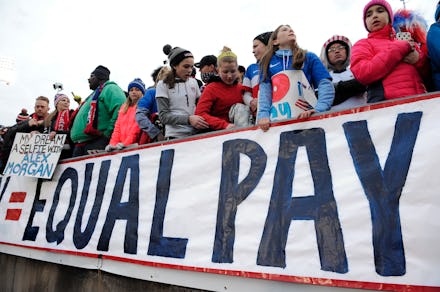3 long-term effects the gender pay gap has on women

On Tuesday, the average woman’s annual income finally “caught up” to what the typical white man earned by Dec. 31. Women earned just 82% of what men did in 2017, meaning it would take them roughly three months and 10 days of additional work to make the same amount of money.
The National Committee on Pay Equity — a coalition of women’s and civil rights organizations — has marked this disparity every year since 1996 with a designation known as Equal Pay Day. And though the gender pay gap has narrowed in the last half-century, there are still areas that need vast improvement if it’s ever going to close for good.
Experts expect the gender pay gap to close by 2059, based on the rate it narrowed between 1960 and 2016. But the most immediate beneficiaries will be white and Asian women, who earn 79 cents and 87 cents to every white man’s dollar, respectively.
Other racial groups will likely require more time. Black women — who make 63 cents for every dollar white men receive — would not see equal pay until 2124, at the current rate. It would take Hispanic women until 2248 to hit the same benchmark. They make 54 cents to the dollar.
It’s clear that slow progress is being made toward gender parity in income across racial lines, albeit at different rates. But the 74.6 million women in the American labor force continue to face long-term economic disadvantages because of the current gap.
Here’s how.
Poverty rates
Failure to pay women equally limits their ability to attain economic stability. If women were paid the same as men, for instance, the poverty rate among working women would decrease from 8.0% to 3.8%, according to the Institute for Women’s Policy Research.
This impacts the children of these women, too. Of the 5.6 million children in poverty today, 2.5 million would come out of poverty if the gender pay gap closed, the study states.
Student loans
A 2018 analysis from the American Association of University Women found that full-time working women who graduated college in 2007 and 2008 had paid off 33% of their student loan debt by 2012. Men who graduated in those same years had paid off 44%.
These numbers differ by race as well. At 61%, Asian women from this cohort had the highest percentage of debt paid off among women. White non-Hispanic women had paid off 37%, black women 9% and Hispanic or Latina women 3%.
Retirement
In October 2017, UBS Wealth Management analyzed the U.S. pay discrepancy for lifetime income between men and women entering retirement.
Researchers ran a set of gender pay simulations — using “Joe” and “Jane” to signify a male and female character, respectively — and analyzed their potential life outcomes. The female character made less than the male character in both scenarios.
But the more researchers adjusted for real-life challenges, the worse the outcomes became. Accounting for time she might have to take off work to care for children or an elderly parent, the female character made 43% less than what the male character made by they time they were 85. When they removed all qualifiers and based their findings on the gender pay gap alone, she made 38% less than what he made by age 85.